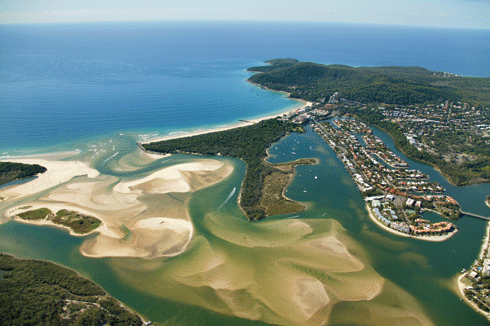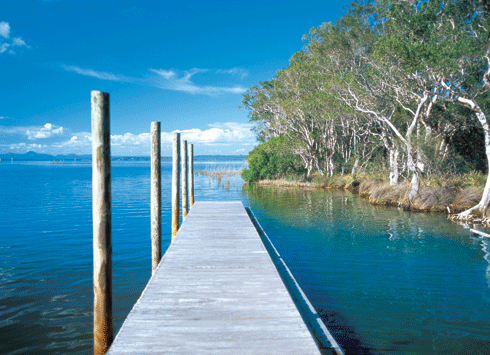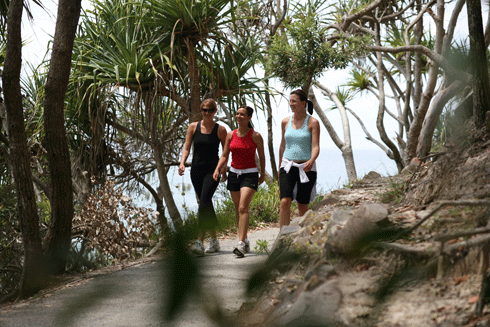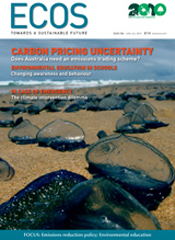
|
Published:
The Noosa Biosphere
In 2007, the Noosa region, at the northern end of Queensland’s Sunshine Coast, was designated a UNESCO biosphere reserve. Matt Mullens looks at the biosphere concept and asks why Noosa fits the bill.

|
|
Noosa river mouth. Credit: Tourism Noosa
|
The landscape of the Noosa region, which is about 130 kilometres north of Brisbane, is a blend of dense eucalypt woodland, lush rainforest and rugged foreshores that overlook the vast Pacific Ocean. It is one of the most ecologically significant regions in Australia.
While Noosa has long been one of Australia’s most iconic tourist destinations – its population swells from 50?000 to more than 65?000 during the summer months – it also has a nobler, far less well-known claim to fame.
In 2007, the region was designated Queensland’s first biosphere reserve. Along with 13 other sites in Australia, it is now one of 564 such sites across 109 countries recognised by the United Nations Educational, Scientific and Cultural Organization (UNESCO) as exemplars of responsible and sustainable development.
The Noosa Biosphere covers approximately 150?000 hectares of terrestrial, freshwater and tidal areas, and includes four national parks, nine conservation reserves, four forest reserves and eight nature refuges. It is home to more than 300 bird and 1300 plant species, many of which are protected by Commonwealth and State legislation.

|
|
Non-stinging jellyfish (Velella velella) on a Noosa beach. Credit: Bettina Walter
|
Also included in the biosphere are the region’s bustling economy and business sector, agricultural activity and thriving tourism industry.
The Noosa Biosphere epitomises the purpose of UNESCO’s Man and the Biosphere (MaB) program, which has the goal of creating an international network of reserves that encourage and demonstrate balanced relationships between people and their environment. The history of the UNESCO biosphere program spans four decades, and began when the first biospheres were designated in the early 1970s.
During its first 20 years, the MaB program was significantly weighted towards the promotion of purely conservation measures. This resulted in the inclusion of many isolated regions that featured little human activity.
A series of self reviews, beginning in the mid-1990s and culminating in the 2008 Madrid Action Plan, led to a new framework for the designation of biospheres that placed a greater emphasis on ecologically sustainable social and economic development. The new framework also stresses the importance of cooperation and information sharing among reserves, and the education of their constituents about sustainability issues.

|
|
Keys boronia (Boronia keysii) is native to the region and has influenced the development of the Noosa Biosphere Logo. Credit: Stephanie Haslam, Noosa’s Native Plants ()
|
It was in this context of renewed focus that the Noosa Biosphere was designated. The MaB biosphere directory declares Noosa is ‘ideal for the creation of a biosphere reserve’. This is largely because for more than 40 years, Noosa has supported ‘one of the earliest and consistently active networks of community conservation groups in the State of Queensland’.1
Ben McMullen, a key architect of the Noosa Biosphere proposal to UNESCO and a member of the Noosa Biosphere Ltd secretariat, believes the region is noteworthy because it was effectively a functioning biosphere well before the proposal was put to UNESCO.
‘There was a logical and natural fit between the MaB program and what had been happening in the Noosa community over many years,’ he says. ‘We have inherited outstanding environmental values from the conservationists of the past, the local government’s movement towards more community integration in decision making, and the striking mix of well-preserved ecological features that don’t occur across this combination of landscapes elsewhere.
‘We had already had a lot of engagement with the community regarding education about sustainable economic and social development; there were quite significant cultural celebrations of our sustainability-based heritage. There have also been number of landmark research projects throughout our history.’

|
|
Noosa Everglades. Credit: Sunshine Coast Tourism
|
MaB reserves are expected to take advantage of their potential as ‘living laboratories’ and design formal research and education programs that contribute to scientific knowledge and raise community awareness about sustainability.
Tim Vercoe is Chair of the Noosa Biosphere Education, Research and Development Community Sector Board, one of six decision-making bodies that drive initiatives in key areas of the biosphere.2 Along with his fellow board members, Vercoe is responsible for directing the organisation’s scientific and educational focus.
‘Our R&D and educational programs are looking at the applied end of sustainable activities. We want to understand sustainability at the local level: what it means in the community, how you measure it and how you know when you’re heading in the right direction,’ Vercoe says.
‘We want to build on that knowledge for our biosphere and pass it back on to the community, but we also want to understand it at a higher level so there may be applications for other biospheres in other communities, both in Australia and overseas.’

|
|
Walkers enjoy Noosa National Park. Credit: Sunshine Coast Tourism
|
For what is effectively a volunteer organisation on a limited budget, it is a grand plan – something Vercoe is quick to acknowledge. But, like McMullen, he believes the biosphere has the advantage of a strong tradition of environmental research, coupled with a strong supply of local scientific expertise.
‘We’re working within a vanishingly small budget by research and development standards, so we definitely need to network and collaborate solidly with people already working within this geographical area, as well as in these areas of science,’ Vercoe says.
‘Fortunately, there is already a significant history within the Noosa Biosphere of environmental monitoring – including some excellent water quality monitoring, biodiversity projects and biological control research based on our waterways – so we’ll be building on that and not just starting off from a blank sheet.’
One of the biosphere’s main projects, conducted in partnership with the University of Queensland, is to produce a systems model of the reserve. The model will map the functioning of the biosphere as a whole, providing an understanding of how the region’s economy, community and environment interact.
‘Systems modelling helps identify the most effective points for intervention,’ says Vercoe. ‘For example, a water quality issue may have its origin in a cultural or economic activity occurring elsewhere in the community. Now, you can do all sorts of things to improve water quality where something’s entering the stream, but to truly resolve the issue you need to go further and find out why the problem’s there in the first place – perhaps it’s a behavioural or social or economic pattern.’

|
|
Noosa hinterland. Credit: Noosa Tourism
|
The Education, Research and Development Sector Board is also coordinating a Biosphere Climate Action Project, examining what the local community can do to adapt vulnerable areas of the region in the face of climate change.
‘We’re looking at what individual households and smaller communities do that is positive in an environmental sense, as well as mitigating and adapting to climate change – which is likely to happen anyway.’
The Noosa Biosphere may prove to be a valuable template for Australian communities working towards lasting balance between socio-economic development and ecological sustainability.
More information:
Noosa Biosphere: www.noosabiosphere.org.au
UNESCO Man and the Biosphere program: www.unesco.org/mab
1 http://www.unesco.org/mabdb/br/brdir/directory/biores.asp?mode=all&code=AUL+14
2 The others are the environment, economic, tourism, cultural and social community sector boards.



